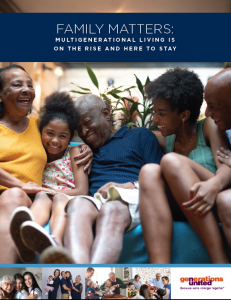
Check out this Report Snapshot
Stories from Multigenerational Families
Read the 2011 Report – Family Matters: Multigenerational Families in a Volatile Economy
A new study from Generations United, Family Matters: Multigenerational Living Is on the Rise and Here to Stay, finds that the number of Americans living in a multigenerational household with three or more generations has nearly quadrupled over the past decade, with a dramatic increase of 271 percent from 2011 to 2021 (7 percent vs. 26 percent). Generations United estimates 66.7 million adults ages 18+ in the U.S. are living in a multigenerational household; that’s more than 1 in 4 Americans. Among those living in a multigenerational household, nearly 6 in 10 (57 percent) say they started or are continuing to live together because of the COVID-19 pandemic. About 7 in 10 of those currently living in multigenerational household plan to continue doing so long-term.
The new study finds 66 percent of those living in a multigenerational household say the economic climate was a factor in their living arrangement. The top reported causes for forming their multigenerational household are the need for eldercare (34 percent), childcare/child education needs (34 percent), job loss/change in job status or underemployment (30 percent), healthcare costs for one or more family members (25 percent), cultural and family expectations (23 percent) and education/retraining expenses (23 percent).
The overwhelming majority of Americans living in a multigenerational home (98 percent) say their household functions successfully, citing various factors that contribute to the success, many of which fall into three categories further delineated in the report: family relationships and interactions, home design and supports and services.
The families also cite many benefits of living together, including:
- Enhanced bonds or relationships among family members (79 percent)
- Making it easier to provide for the care needs of one or more family members (79 percent)
- Improved finances for at least one family member (76 percent)
- Positive impacts on personal mental and/or physical health (76 percent)
- Making it possible for at least one family member to continue school or enroll in job training (71 percent)
Despite the successes and benefits, it’s not surprising that 75 percent note it can be stressful at times.
The report includes demographic data as well as the following recommendations:
- Increase multigenerational housing stock and affordability.
- Promote multigenerational living as an environmentally friendly housing option.
- Expand access to affordable, high-quality child and adult daycare including co-locating care by developing more intergenerational shared sites.
- Expand paid family leave and flexible work environments.
- Increase access to home and community-based supports.
- Support innovative intergenerational approaches to education at home.
Family Matters: Multigenerational Living is on the Rise and Here to Stay includes the findings of a 2021 survey conducted online within the United States by The Harris Poll on behalf of Generations United from January 28-February 1, 2021 among 2,051 U.S. adults ages 18 and older, among whom 441 live in a multigenerational (at least 3 generations) household. The 2011 survey was conducted online within the United States by The Harris Poll on behalf of Generations United from September 27-29, 2011 among 2,226 U.S. adults ages 18 and older, among whom 136 lived in a multigenerational (at least 3 generations) household These online surveys are not based on a probability sample and therefore no estimate of theoretical sampling error can be calculated. For complete survey methodologies, including weighting variables and subgroup sample sizes, please contact Generations United at gu@gu.org.